The reality of unarmed African American women being beaten, profiled, sexually violated and murdered by law enforcement officials with alarming regularity is too often ignored.
Like so many African American women, myself included, Sandra Bland’s death, resulting from police brutality is not new news. The national attention it’s receiving is, however.
The reality of unarmed African American women being beaten, profiled, sexually violated and murdered by law enforcement officials with alarming regularity is too often ignored – especially with the focus of police brutality on African-American males.
And when gender identity and sexual orientation come into play, the treatment by police can be harsher. For example, my spouse, who would drive her new BMW (a vehicle cops believe is stolen if a black male is behind the wheel) to and from work, was stopped suspiciously too often for the classic case of “driving while black.” And when the Cambridge cops realized she’s a woman, and a lesbian one at that, their unbridled homophobia surfaced. My spouse now takes the bus or walks to work as much as she can due to the trauma from the constant shakedowns.
A new report and campaign called “Say Her Name” addresses the lack of reporting, documenting, and accounting for the violations and death of African American women and girls at the hand of law enforcement officials.
Just last July, Marlene Pinnock’s, 51, beatdown by California Highway Patrol officer Daniel Andrew was captured by a passing driver and spread widely on both internet and television. With Andrew straddling Pinnock on the ground and pummeling her with his fist, Pinnock told CBS News “He was trying to beat me to death….take my life away. For no reason. I did nothing to him.”
While it is not shocking news that African American women are arrested more often than white women in any given city across the country, what is shocking is the rate at which we are.
For example, a new report from the Center on Criminal and Juvenile Justice reveals that while African American women in San Francisco comprise of approximately 5.8 percent of the city’s female population, they make up 47 percent of female arrests. And these arrests too often result in death.
African American sisters like Rekia Boyd (March 2012, Chicago), Kimberlee Randle-King (September 2014, St. Louis), and Natasha McKenna (April 2015, Fairfax County, Virginia), to name just a few, are lives cut too short at the hands of law enforcement officials. While the country was reeling from the news of Bland’s death of July 13th, 18-year-old Kindra Chapman of Alabama was found dead in her jail cell following day.
Oddly, Randle-King’s, Bland’s and now Chapman’s death are all explained away as “self-inflicted asphyxiation,” a form of suicide extremely uncommon among African Americans given our not-to-distant relationship with this country’s history of lynching. And while African American women comprise the largest demographic group of females incarcerated, statistics reveal that black women committing suicide is the lowest of all groups, and hanging is not our method of choice.
The perceptions and stereotypes of African American women—combative, mouthy, not deferential enough and “angry black woman”—can sadly turn into deadly action as we see with Bland. Bland’s crime is what’s described as “contempt of cop.” She wasn’t obsequious or subservient enough when the officer asked her to extinguish her cigarette. And for something as minor as a traffic signal violation, the incident escalated out of control. But when the dominant culture doesn’t see and hear African-American voices about our pains, fears, vulnerabilities our humanity is distorted and made invisible through a prism of racist and sexist stereotypes. So, too, is our suffering.
When Bland was found hanging from a noose made of plastic bags in her Waller County jail cell, the coroner’s report corroborated the claim stating there were no obvious signs of such a violent struggle. But like Bland’s family and friends, I, too, cry out foul play. And it’s because of Waller County’s long and prideful history for keeping blacks in their place, and lynching was the preferred method.
I posit that if Bland did not commit suicide then clearly it was a lynching—a reality in 2015 too harsh and hard to fathom, even in a remote and still racially segregated corner of Texas.
But Waller County, which is less than an hour north of Houston, was a county notorious for lynching, and old habits die hard, if they die at all. The Equal Justice Initiative states that African Americans were lynched disproportionately higher in Waller County than in any other county in the state between 1877 and 1950. The memories of family and friends lynched still lives on in the collective oral history of Waller County’s African American community. “In this county, they’ve been hanging and killing Negroes since the Civil War.” an old buddy of Bland’s, Holice Cook, told the Washington Post.
When Bland tweeted on April 8th “AT FIRST THEY USED A NOOSE, NOW ALL THEY DO IS SHOOT #BlackLivesMatter #SandySpeaks,” she, too, could not fathom such act.
But with the recent deaths of Randle-King’s, Chapman’s and Bland’s there’s a pattern evolving, one in which sadly we cannot conclusively hang up the thought of lynching for good.
